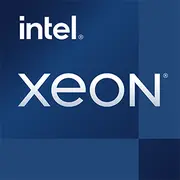Intel Xeon W-10855M

Intel Xeon W-10855M: A Processor for Mobile Workstations in 2025
Analyzing Capabilities, Use Cases, and Competitiveness
1. Architecture and Process Technology: Comet Lake in the Age of 3nm
The Intel Xeon W-10855M processor, released in 2020, is based on the Comet Lake-H microarchitecture and is manufactured using a 14nm process technology. Although by 2025 dominance lies with 5nm and 3nm chips (such as Apple M4 or AMD Zen 5), Comet Lake remains relevant in the mobile workstation niche due to its stability and proven solutions.
Key Specifications:
- 6 cores / 12 threads with a base frequency of 2.8 GHz and a maximum turbo frequency of 5.1 GHz (for a single core).
- Integrated graphics Intel UHD for the 10th generation (32 EU, frequency up to 1.2 GHz).
- Support for DDR4-2933 MHz (up to 128 GB) and ECC memory — a key feature of Xeon.
Architecture Features:
- Hyper-Threading for multithreaded workloads.
- Turbo Boost Max 3.0 and Thermal Velocity Boost technologies for automatic overclocking at low temperatures.
- The integrated GPU is suitable only for basic tasks: office applications, 4K video encoding, but not for modern gaming.
2. TDP 45W: Balancing Power and Heat
A Thermal Design Power (TDP) of 45W indicates a classification within high-performance mobile processors. Unlike ultrabooks (15-28W), the Xeon W-10855M requires:
- An efficient cooling system with two fans and heat pipes.
- A thick laptop chassis (from 20mm).
Practical Example: The Dell Precision 7550 laptop with this CPU heats up to 85–90°C under load, but throttling (frequency reduction) does not occur thanks to a well-designed cooler.
3. Performance: Real Tasks and Turbo Mode
Geekbench 6:
- 1472 points (single core) — comparable to Intel Core i7-11800H.
- 5722 points (multithreading) — on par with Ryzen 7 5800H.
Use Cases:
- Office Work: In Chrome with 50 tabs + Excel + Zoom — no delays.
- Multimedia: Rendering 4K video in DaVinci Resolve takes ~25–30 minutes (compared to 15–18 minutes with Apple M3).
- Gaming: Using integrated graphics — only CS2 at low settings (40–50 FPS). With a discrete GPU (NVIDIA RTX A2000) — Cyberpunk 2077 at medium settings (50–60 FPS).
Turbo Mode: The processor can maintain frequencies up to 4.4 GHz (all cores) for 2–3 minutes, after which it reduces to 3.9 GHz to avoid overheating.
4. Use Cases: Who is the Xeon W-10855M Suitable For?
- Engineers and Designers: ECC memory support is critical for CAD applications (AutoCAD, SolidWorks) where memory errors are unacceptable.
- Data Analysts: Multithreading accelerates processing in Python/R.
- Mobile Workstations: Laptops for 3D modeling, rendering, and virtualization (e.g., VMware).
Not Suitable For:
- Gamers who prioritize battery life and FPS in AAA games.
- Ultrabook users: the thickness and weight of devices with Xeon W-10855M start from 2.5 kg.
5. Battery Life: The Cost of Performance
Under active load (rendering, code compilation), laptops with this CPU run on battery for 1.5–2 hours. In office mode (50% brightness, Wi-Fi) — up to 5–6 hours.
Power-saving Technologies:
- Intel Speed Shift — dynamic switching between P-states.
- Adaptix Thermal Framework — optimizing cooler performance.
Tip: To extend battery life, disable Turbo Boost in the BIOS settings — this will reduce performance by 20–25% but add 1–1.5 hours of runtime.
6. Comparison with Competitors
- AMD Ryzen 9 PRO 6950H (Zen 3+, 6nm): Better energy efficiency (+30% battery life), but lacks ECC memory in most models.
- Apple M3 (3nm): 2–3 times higher speed in rendering, but limited compatibility with Windows software.
- Intel Core i9-11980HK: Higher gaming performance but lacks ECC and stability under long loads.
Conclusion: The Xeon W-10855M is the choice for those needing reliability rather than record FPS or battery life.
7. Pros and Cons
Strengths:
- Support for ECC memory and vPro for enterprise security.
- Stable operation under 100% load.
- Compatibility with Windows/Linux and professional software.
Weaknesses:
- The 14nm process technology is outdated: high power consumption and heat.
- Integrated graphics are weaker than those in Ryzen 6000/7000.
- Price: laptops with this CPU start at $2200 (new stock in 2025).
8. Recommendations for Choosing a Laptop
- Device Type: Only mobile workstations — Dell Precision 7560, HP ZBook Fury 17 G8, Lenovo ThinkPad P15.
- What to Look For:
- Cooling system: at least 2 fans + 4 heat pipes.
- Discrete graphics: NVIDIA RTX A3000 or AMD Radeon Pro W6600.
- Display: 100% sRGB or Adobe RGB for designers.
Example Configuration for $2500:
- Xeon W-10855M + 32 GB DDR4 ECC + 1 TB SSD + NVIDIA RTX A2000.
9. Final Conclusion
The Intel Xeon W-10855M in 2025 is a niche solution for:
- Engineers working in the field with demanding software.
- Corporate users valuing stability and ECC memory.
- IT specialists deploying virtual machines on a laptop.
Alternatives: If ECC is not needed, consider AMD Ryzen 9 PRO 7940HS or Apple MacBook Pro 16 M3 — they offer better performance and battery life.
Prices and models are accurate as of April 2025. When choosing a laptop, check with suppliers for processor availability — new devices with Xeon W-10855M are rarely found but remain on the market as specialized solutions.
Basic
CPU Specifications
Memory Specifications
GPU Specifications
Miscellaneous
Benchmarks
Compared to Other CPU
Share in social media
Or Link To Us
<a href="https://cputronic.com/en/cpu/intel-xeon-w-10855m" target="_blank">Intel Xeon W-10855M</a>